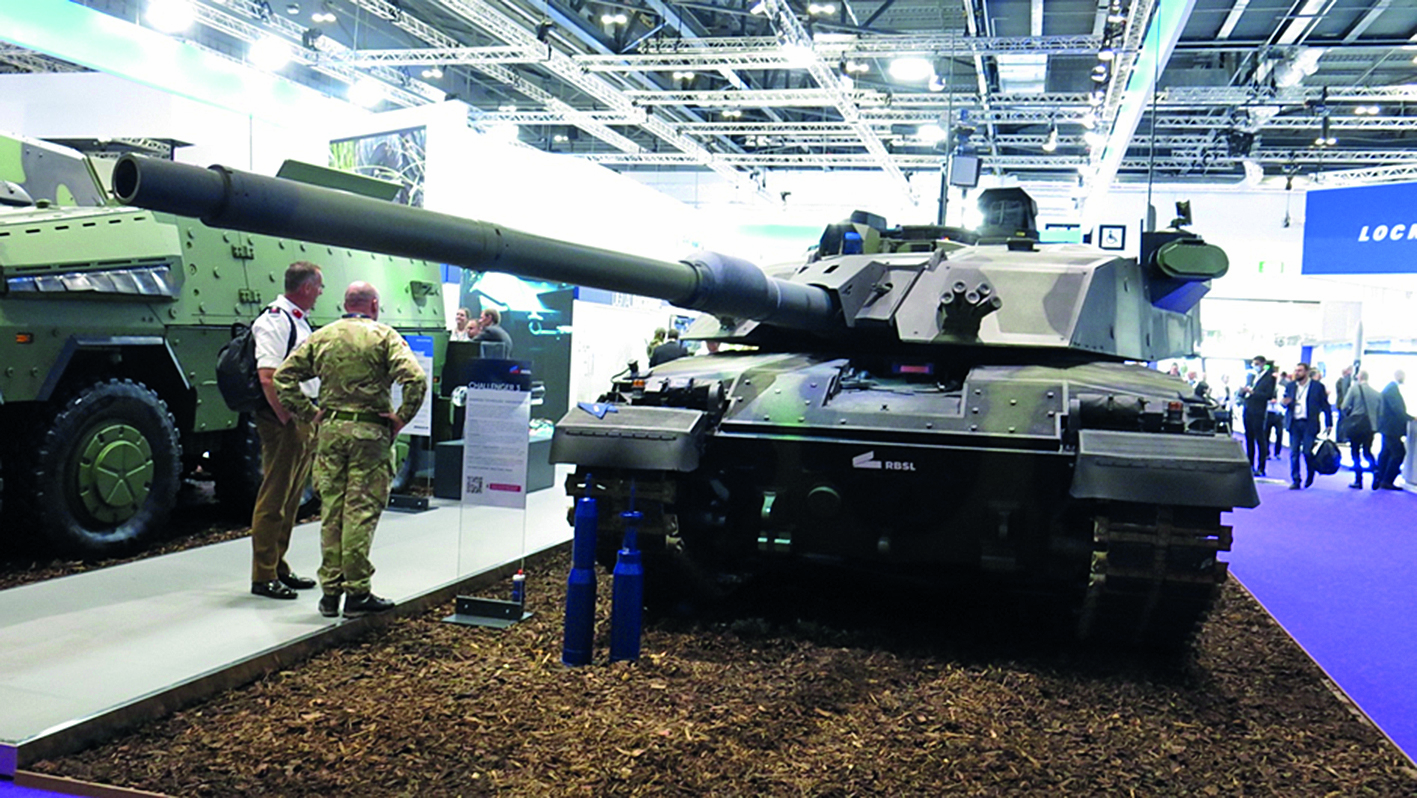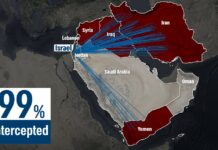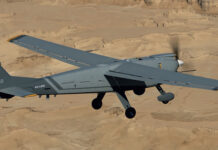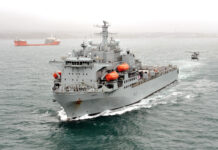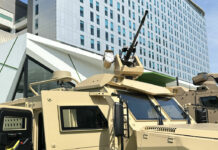Israel has been a forerunner of armoured Vehicle Protection Systems (VPS) and Active Protection Systems (APS) for more than 20 years. The demand for such capabilities evolved during the 19-year occupation of South Lebanon (1982-2000), where Israeli tanks and other heavy armoured vehicles were exposed to attacks on road patrols and in static positions. Israel’s Defence Forces (IDF) have developed and tested several such countermeasures, used primarily against guided missiles fired by Hezbollah. Some of those systems relied on activating IR jammers to defeat Anti-Tank Guided Missiles (ATGM) using Semi-Active Command to Line-Of-Sight (SACLOS) – such as the BGM-71 TOW and 9K115-2 ME- TIS. Toward the end of that war, the IDF conducted an operational test of PURPLE THUNDER, an experimental APS that combined radar to detect the approaching missile that automatically triggered jammers and smoke screens to protect MERKAVA Mk2 tanks.
Unfortunately, PURPLE THUNDER has not reached operational use, and, at the break of the Second Lebanon War in 2006, Israeli armour was ill-prepared to deal with the ATGM threat. Of particular concern was the laser-beam-riding 9M133 KORNET, which could be fired from long range, with minimal signature, and was impossible to jam by soft kill countermeasures.
Pioneering APS Technology
Lessons learned during that war brought the IDF to revive APS developments that included two different concepts. The TROPHY system, developed by Rafael Advanced Defense Systems, was designed to defeat RPGs, ATGM, and tank rounds. Relying on a radar sensor to detect the threat at a long range, TROPHY activates explosively formed projectiles (EFP) countermeasures to defeat a threat at a long-range. These charges are well-aimed to meet the incoming threat at a relatively long distance from the protected vehicle, destroying it by a direct impact. The intercept distance is long enough to avoid damage even if the inter- cept activates the shaped charge in the mis- sile’s warhead. A quick reloading process follows the EFP firing. The reloader quickly positions another EFP charge, enabling the tank to maintain its protection even under a ripple attack by RPGs and ATGMs.
IRON FIST was another system was devel- oped by Israel Military Industries (IMI – now a division of the Elbit Systems company). This system used a combination of passive (EO) and radar sensors to launch an explo- sive charge that creates a powerful blast wave that crushes the incoming projectile at a safe distance from the protected vehi- cle. This method disrupts the initiation of the shaped charge.
By design, IRON FIST Light Decoupled (IFLD) is optimised to fit to the platform constraints to provide multi- layered protection. When SACLOS threats are detected, the system engages the ATGM with soft kill while hard kill would be used against beam riders like the KORNET, RPGs, or HEAT projectiles fired by tanks and recoilless rifles. The IRON FIST Light Kinetic (IFLK) system has some capability to defeat kinetic energy (KE) rounds, as the blast wave deflects the long-rod penetrator on its path, thus degrading its effectiveness in penetrating heavy armour.
The Eyes of the APS
Both systems rely on the radar for threat detection, classification, and target acqui- sition. TROPHY uses the IAI Elta Systems’ WindGuard radar to enable its long-range hit-to-kill effect. Rada developed the Compact Hemispheric Radar (CHR) to meet the parameters of IRON FIST. The latest versions of these systems are enhanced with multi-mission capabilities to perform Hostile Fire Detection (HFD), close-range area, and aerial surveillance.
Elta’s ELM-2133 WindGuard radar is a four-facet distributed phased-array pulse- Doppler radar designed to detect and automatically track Anti-Tank Rockets (ATRs), Anti-Tank Guided Missiles (ATGMs), and tank rounds. Upon detection and identifi- cation of a potential threat, the radar delivers early warning to the crew, indicating the accurate 3D direction of the threat, calculating the Time-To-Impact (TTI), and – when deemed an imminent threat to the vehicle – automatically activates TROPHY’S hard-kill protection system for optimal reaction. The radar warning and APS response only to direct threats, but with the ability to calculate the location of the threat launch- ing point, it facilitates rapid weapon aim- ing at the threat.
IAI also offers a multi- mission radar of this type – the ELM 2135 StormGuard multi-mission radar for simi- lar purposes, enabling armoured vehicles to extend their situational awareness of low signature threats including crawling and slow-moving persons, vehicles of all types and moving patterns, and aerial threats, including drones and UAVs, in addition to anti-armour threats. WindGuard can also be integrated with EO sensors to provide Hostile Fire Detection (HFD).
Elta Systems’ OTHELLO (ENA5220) provides this capability. It comprises an ar- ray of EO sensors designed to detect gunfire, mortar, RPG, and ATGM. The system consists of two sensors. The arc-shaped OTHELLO-P with a field of view of 190×40 degrees provides a rough indication of a gunshot, RPG, or ATGM launch, enabling the vehicle to manoeuvre and activate soft kill measures or an instant smoke screen. The box-shaped OTHELLO system uses more sensors to cover 90×60 degrees with an accuracy level sufficient for slew-to-cue of weapons and APS to engage the target with counter-fire or hard kill.
Multi-Layered Defence
Rada has recently introduced the second generation of multi-mission CHR that improves the situational awareness of land-based and aerial threats, including UAVs and loitering weapons. CHR utilises the latest technology of Active Electronic Scanning Arrays (AESA) and Gallium Ni- tride (GaN) amplifiers that deliver high agility. Two systems are available – the aCHR tailored for VPS, APS, and HFD and the eCHR, optimised for Counter-Unmanned Aircraft System (C-UAS) and Very Short-Range Air Defence (VSHORAD) missions. These software-defined radars provide automatic and complete dynamic Air Situational Picture (ASP) with four units mounted on each tactical vehicle using advanced signal processing and al- gorithms. Together they handle hundreds of targets simultaneously through Track While Search (TWS) and revisit modes, analysing target in-depth in a 4D analysis of Doppler and other target features.
Since its early day’s, IRON FIST was designed as a multi-layered vehicle protection system protecting from ATGM, RPG, and tank round – both HEAT and long-rod penetrators (KE). The system was designed to counter each threat with the least costly method – SACLOS (2nd Generation) ATGMs would be engaged with infrared countermeasures (IR jam- mers), while RPGs, KE, and HE would re- quire hard kill in different schemes. ARIEL Photonics cloud soft-kill systems initially provided IRON FIST’s soft-kill layer. Such a system included a missile warning sensor (radar or optical), a tracker, and a laser jammer.
Elbit Systems also offers a soft kill layer for its VPS with the EO SHIELD, Vehicle Infra-Red Countermeasure System (VIRCM) that protects armoured fighting vehicles against SACLOS guided anti-tank guided missiles. Other methods employ a laser jammer mounted in line with the IRON FIST launcher. The jammer is linked to the threat warning sensors in this configuration to obtain early warning and target classification. Unlike a hard-kill APS with a limited magazine against multiple attacks, VIRCM can be used continuously and in all directions to engage multiple incoming threats until the attacking missile veers off its course. If the missile is not affected, other layers of defence are used.
Combat-Proven Systems
TROPHY was first to reach operational use, with the first operational deployment on the Gaza strip in 2011. The system demonstrated its effectiveness against real threats in battle numerous times. These threats included 9M113 KORNET, advanced (tandem) RPGs and 9M113 KONKURS. According to Rafael, TROPHY systems have accumulated over 1,000,000 operational hours. TROPHY systems have been mounted on MERKAVA Mk 4 and 3 and NAMER AIFVs. For lighter vehicles, such as the EITAN 8×8 APC, the IDF opted the use the IRON FIST for its lighter weight and ability to operate with open hatches without the TROPHY’s shield deflectors. IRON FIST that has been selected to provide the APS for the 8×8 EITAN wheeled APC is expected to mature toward the initial operational deployment of EITAN with the Nahal infantry brigade, scheduled soon.
Although it took over 20 years to mature, today, TROPHY remains the world’s first and only combat-proven APS. Wars in Ukraine, Caucasus, North Africa, and throughout the Middle East, where modern battle tanks and heavy armour were defeated by unguided rocket-propelled and guided weapons, brought many armies to the understanding that the time for APS has come. The US Army was first to recognise its role, adding TROPHY as another layer of protection for its M1A2 MBTs based in Europe. Germany has followed Exporting the US with the integration and fielding of the first platoon of LEOPARD 2A7 equipped with the system. TROPHY is also integrated and is likely to become part of the planned modernisation of the British CHALLENGER 3 main battle tank.
Overseas Involvement
Rafael pursues new opportunities through collaboration with international partners. In the USA, Rafael cooperates with Leonardo. In Europe, they established a JV with KMW and General Dynamics European Land Systems (GDELS) to market and support TROPHY integration in the scope of existing and new European armoured vehicles programmes, including the LEOPARD MBT community. TROPHY also supports wheeled APCs. It has been integrated on the Canadian LAV III APC and installed for a demonstration on the GDLS STRYKER for the tests by the US Army. The system has been integrated into Rafael’s SAMSON MKII turret currently offered to several NATO countries for AFV modernisation programmes. Although Rafael has expanded the TROPHY family with a reduced weight version for medium armoured vehicles and a light version for light wheeled vehicles, TROPHY HV continues to be the system of choice for customers as it is the most mature and proven APS.
IRON FIRST received a boost following the acquisition of IMI by Elbit Systems. Leveraging Elbit’s strong marketing position and IMI’s expertise, the IRON FIST programme was streamlined and integrated with other product lines and cooperation programmes. Two examples are the Dutch CV9035/NL modernisation, underway with BAE Systems, and integration with the BOXER APC and LYNX IFV for the Australian LAND 400 programmes. The integration with the remotely operated turret used on the Hanwha REDBACK AIFV, a competitor to the LYNX in the Australian LAND 400 Phase 3 programme, also represents the system’s ability to integrate with new unmanned turrets, such as Elbit Systems’ UT30MK2.
The Way Forward
Both systems are being offered as part of complete integrated turrets. Having the APS as part of the turret mechanical and electronic design help reduce integration cost and reduce weight. Being a part of a comprehensive battle management system (BMS) allows the APS sensors to become part of the vehicle’s situational awareness, providing:
- early warning
- weapon laying information
- target acquisition for onboard and remotely operated weapons


